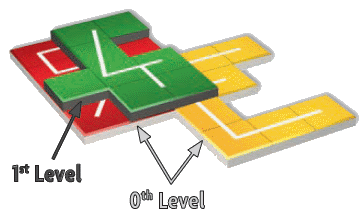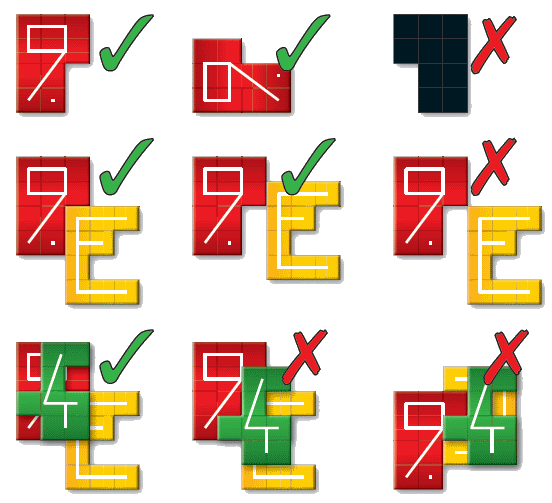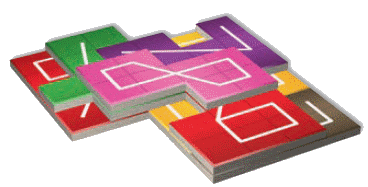|
|
If you are reading these rules for the first time, ignore the text along the right hand side. These rules serve as a summary to help you quickly familiarize yourself with the game.
Show
→ summary only
→ detailed version only
→ both summary and detailed version
In NMBR 9, each player uses the same number tiles
to form his own display. In doing so, he tries to put each tile on a level
as high as possible – the higher a number tile is placed, the more points
it generates at the end of the game. The player with the most points wins.
Game Components
80 number tiles, 8 each with numbers from '0' to '9':
Setup
Place the number tiles well-reachable for all players in the middle of the table.
Shuffle the number cards and put them as a face-down draw pile in the middle of the table.

Levels
Any number tile that has been placed directly on the surface of the table
during the course of the game is considered to be at the 0th level. When, later
on, number tiles are put directly on top of the tiles of the 0th level, they are
then at the 1st level, and so on.

Squares
Each number tile is divided into squares. The number of squares of a tile has
nothing to do with the number on the tile. The squares just indicate the grid in
which additional tiles have to be connected or placed on top.
COURSE OF THE GAME
The game goes over 20 rounds.
At the start of each round, one of the players draws a number card.
All players simultaneously place the indicated number tile based on the following rules:
- Number tiles may be rotated.
- Number tiles must be placed adjacent to each other.
- Number tiles that are not placed at level 0 must be placed on top of at least two number tiles without any overhang.
The game goes over 20 rounds.
At the beginning of each round, one of the players draws the top number card from the draw pile and announces aloud the
number shown; he then puts the card face up on the discard pile.
Now all players take one number tile each with the just-announced number from the box and, at the same time, think of
how to place it best in their own display.
In the first round, you simply put the number tile in front of you in any orientation, with the number side facing up. You
should leave enough space around this tile for additional tiles you’ll place later on.
In general, the following placement rules apply:
-
 The number tile always has to be placed with the
number side facing
up
, but the orientation may be chosen freely.
The number tile always has to be placed with the
number side facing
up
, but the orientation may be chosen freely.
-
If you want to put the number tile on a level where at least one
other tile is lying, at least one side of a square on this tile has to be
adjacent to a square of a tile already laid-out there (pay attention to
the grid).
-
If you want to place the number tile on the 1st level or higher, it has
to lie completely on top of squares of the number tiles underneath
(pay attention to the grid). Consequently, you are not allowed to
place tiles so they protrude or are built over gaps.
In addition, the new number tile has to lie on squares of at least two number tiles underneath.
Consequently, it may never lie on only one tile.
Attention: The 2nd placement rule applies to all levels: At least one side of a square of any additional
tile to be placed on a level has to be adjacent to a square of a tile already laid-out there.
When all players have placed the number tile in their display, the current round ends and players draw another number
card for the next round.
General hints
-
A number tile does not have to be placed on the highest level currently possible. You may decide for each tile which
level to place it on.
-
During a round, you may try out different ways to fit the number tile that you are going to put in your display. But once
you have made your decision, you may no longer move the tile.
-
You may take only that tile from the box that has been announced for the current round. You may not use other tiles to
try out whether these might be good to add later on.
-
If one player takes a lot of time placing his tile, the other players may prompt him to place it within the next minute.
-
Play is creative: If somebody completely copies another player’s display, he can never gain more points than the others.
END OF THE GAME
The game ends after the round in which the draw pile has been depleted.
Scoring
Each number tile's score is calculated as number value multiplied by level.
The player with the most points wins.

Example: An "8" on the 2nd level scores 8 x 2 = 16 points.
Now, beginning with any participant, one player after another scores his
display. To this end, he takes the display apart from top to bottom, adding
up the points for each number tile and writing down the result, if need be.
The following scoring rule applies:
The number on the tile is multiplied by the level.
Important: This means that the number tiles on the 0th level always score
0 points; they have no value at the scoring.
The player with the most points wins. In case of a tie, the players involved share the win.
Variant
Before the game begins, a randomly determined number of number cards, for example two, can be removed from the game.
This means that the players cannot plan exactly which number tiles can still be placed.
Number cards are not explicitly part of the Yucata version of NMBR 9.
Instead, the players are automatically given a number tile to place at the start of each round.
The number tile placement of other players only becomes visible after all players have placed their number tile.
| |